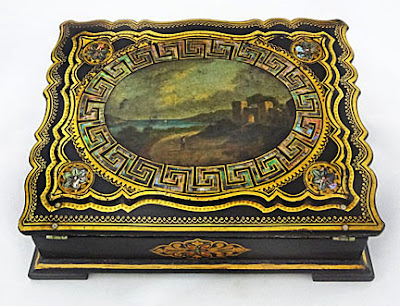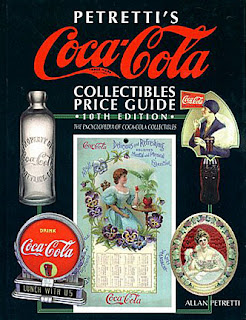 QUESTION: When I think of papier-maché, I remember my days in school art classes soaking strips of paper in a mixture of flour and water from which I made a variety of shapes, including puppet heads and fruit, and weird sculptures. But I just saw some rather elegant objects made of papier-maché at a recent antique show. These looked nothing like my crude art class creations. How did they get papier-maché to look so good? And are these objects worth collecting?
QUESTION: When I think of papier-maché, I remember my days in school art classes soaking strips of paper in a mixture of flour and water from which I made a variety of shapes, including puppet heads and fruit, and weird sculptures. But I just saw some rather elegant objects made of papier-maché at a recent antique show. These looked nothing like my crude art class creations. How did they get papier-maché to look so good? And are these objects worth collecting?
ANSWER: During the early 19th century, every household had a least one useful object made of papier-maché.
The Chinese invented papier-maché soon after they invented paper in the second century. In Europe the industry developed in France in the 1650s with small decorative objects, such as boxes made of used paper gathered during the night by billboard strippers. By the early 1760s, Germany had its first papier-maché factory. Russia gained world renown for its lovely hand-painted papier-maché boxes, decorated with landscapes, peasants and scenes taken from Russian folklore.
 The term papier-maché is French and means crushed paper. Papier-maché consists of several layers of thick damp paper and vegetable matter pressed together into sheets in an iron mold and then oven dried. After workers took it out of the mold, they coated it with multiple coats of varnish—a process called “japanning,” thus waterproofing it and making it ready for decoration. After artists decorated the item, they applied a final coat of clear varnish to protect it.
The term papier-maché is French and means crushed paper. Papier-maché consists of several layers of thick damp paper and vegetable matter pressed together into sheets in an iron mold and then oven dried. After workers took it out of the mold, they coated it with multiple coats of varnish—a process called “japanning,” thus waterproofing it and making it ready for decoration. After artists decorated the item, they applied a final coat of clear varnish to protect it.
In England the papier-maché industry quickly followed the introduction of paper making around 1690. At first people used the pulped paper for interior decoration and architectural ornaments because it was a less expensive than other building materials. Then they applied it to picture and looking glass frames and small ornamental moldings. By 1766, John Taylor of Birmingham had begun to make buttons and snuff boxes.
 In 1772 Henry Clay, also of Birmingham, patented a process for making heat-resistant, hand-smoothed panels of papier-maché. These stronger panels could be sewn and dovetailed just like real wood and were perfect for making furniture.
In 1772 Henry Clay, also of Birmingham, patented a process for making heat-resistant, hand-smoothed panels of papier-maché. These stronger panels could be sewn and dovetailed just like real wood and were perfect for making furniture.
In 1816, Aaron Jennens and T.H. Bettridge purchased Clay’s factory, which had become the top producer of high quality papier-maché. Jennens developed a technique in which panels could be softened with steam to enable manipulation into a heated metal mold. Workers then screwed a counter mold into position and heat-dried the steam-molded panels. The result was a hard, pre-shaped product of even thickness. By reducing the number of steps and the amount of time required to mold furniture, Jennens revolutionized the process and opened the door to mass-production.
Jennens and Bettridge expanded the traditional repertoire of salvers and snuff boxes to produce papier-maché household furnishings on a larger scale for the English Victorian home.
 One of the earliest and most popular papier-maché items was the snuff box. The habit of taking snuff began in England in the 17th century and by the beginning of the 18th century over 7,000 shops in London sold snuff.
One of the earliest and most popular papier-maché items was the snuff box. The habit of taking snuff began in England in the 17th century and by the beginning of the 18th century over 7,000 shops in London sold snuff.
Papier-maché was an ideal material for snuff boxes because it was cheap and maintained the snuff at the correct humidity. The earliest boxes had no rim, but makers added them later, making a frame for the decoration. They were rectangular or circular in shape, and many snuff boxes had hand-painted ' decoration, usually scenes from famous paintings. Top quality ones came from the workshops of Samuel Raven, who signed most of his work on the inside of the lid.
By the late 18th century, papier-maché trays had become popular. Before long, middle class families didn’t think their homes were complete without a nest of papier-maché trays. Jennens and Bettridge presented a set of three elaborately decorated trays to Queen Victoria on her marriage to Albert in 1840.
 The great interest in papier-maché trays resulted in the development of new shapes with a variety of elaborate designs. Shapes were rectangular, octagonal, oval and a form called Gothic. One variety of the Gothic, known as the "parlor maid tray," had one side curved to fit the maid’s waist for support when the tray was heavily laden with tea service items. George Wallis of the Old Hall Works at Wolverhampton created an oval scalloped tray which he called the "Victoria" in honor of the young queen.
The great interest in papier-maché trays resulted in the development of new shapes with a variety of elaborate designs. Shapes were rectangular, octagonal, oval and a form called Gothic. One variety of the Gothic, known as the "parlor maid tray," had one side curved to fit the maid’s waist for support when the tray was heavily laden with tea service items. George Wallis of the Old Hall Works at Wolverhampton created an oval scalloped tray which he called the "Victoria" in honor of the young queen.
Letter writing was of great social importance during the Victorian period, and a complete set of writing materials was provided in the guest rooms of wealthy homes, often made of papier-maché. Lap desks were popular with Victorian ladies. The writing board lifted up to expose stationery and compartments for ink bottles, pen and postage stamps. When the user closed the beautifully decorated cover, the compact lap desk could be kept anywhere as a decorative piece.
Inkstands were also frequently made of papier-maché. They usually had a box for sealing wax placed between two crystal ink bottles with a slot for pens in front. Other papier-maché items used for letter writing were blotters, desk-folio's and letter racks.
 True lacquer comes from the resin of a tree of the sumac family indigenous to the Orient, and in the Far East this resin dries quickly upon exposure to sunlight. Since the lacquer didn’t set properly in the wet English climate, its effect had to be duplicated by various varnishes in a process referred to as "japanning."
True lacquer comes from the resin of a tree of the sumac family indigenous to the Orient, and in the Far East this resin dries quickly upon exposure to sunlight. Since the lacquer didn’t set properly in the wet English climate, its effect had to be duplicated by various varnishes in a process referred to as "japanning."
Japanning is a British imitation of Oriental lacquer, pioneered by Henry Clay. He dissolved resin in alcohol, then added sizing from boiled parchment along with a whitening material. He applied this to a wooden base, then polished and decorated the surface..
 From the beginning, makers of papier-maché housewares japanned them. At first the decoration was simple, with a black or red ground embellished with a guilt border. But in the 1790's, they began to decorate the entire surface. Not surprisingly, Chinese scenes were popular.
From the beginning, makers of papier-maché housewares japanned them. At first the decoration was simple, with a black or red ground embellished with a guilt border. But in the 1790's, they began to decorate the entire surface. Not surprisingly, Chinese scenes were popular.
During its early days, makers of papier-maché items decorated them with metal powders and alloys, applying them with a swab, rather than a brush. Typically, most pieces have a painted floral decoration on a black ground, a characteristic look of Victorian papier-mâché,
 Jennens and Bettridge changed the way they decorated their papier-maché, especially with the extensive use of mother-of-pearl as an in-lay material. Inlaid mother-of-pearl then became the most popular method of decorating papier-maché items, along with painting and gliding.
Jennens and Bettridge changed the way they decorated their papier-maché, especially with the extensive use of mother-of-pearl as an in-lay material. Inlaid mother-of-pearl then became the most popular method of decorating papier-maché items, along with painting and gliding.
Manufacturers used landscapes, flower designs, animals, and insects to decorate their pieces. Geometric motifs were also very popular. Artists hand-painted miniature portraits and pictures of castles and famous buildings on some pieces of papier-maché, especially small snuff boxes.
Decorations varied almost as much as the many articles made from papier-maché. Although manufacturers of papier-maché items usually japanned them, some items had green, red or yellow backgrounds. To read more articles on antiques, please visit the Antiques Articles section of my Web site. And to stay up to the minute on antiques and collectibles, please join the over 30,000 readers by following my free online magazine, #TheAntiquesAlmanac. Learn more about "The Vernacular Style" in the 2024 Winter Edition, online now. And to read daily posts about unique objects from the past and their histories, like the #Antiques and More Collection on Facebook.














